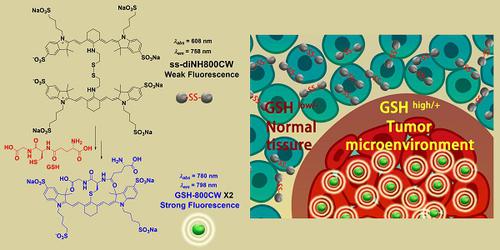Theranostics ( IF 12.4 ) Pub Date : 2020-01-01 , DOI: 10.7150/thno.39673 Shanyan Mo 1, 2 , Xiaoting Zhang 1 , Sadaf Hameed 1 , Yiming Zhou 1 , Zhifei Dai 1

|
Near-infrared (NIR) fluorescence imaging has been proved as an effective modality in identifying the tumor border and distinguishing the tumor cells from healthy tissue during the oncological surgery. Developing NIR fluorescent probes with high tumor to background (T/B) signal is essential for the complete debulking of the tumor, which will prolong the survival rate of tumor patients. However, the nonspecific binding and “always-on” properties of the conventional fluorescent probes leads to high background signals and poor specificity.
Method: To address this problem, glutathione (GSH)-responsive, two disulfide-bonded dicyanine dyes (ss-diCy5 and ss-diNH800CW) were synthesized. As synthesized dyes are quenched under normal physiological conditions, however, once reached to the tumor site, these dyes are capable of emitting strong fluorescence signals primarily because of the cleavage of the disulfide bond in the tumor microenvironment with high GSH concentration. Besides, the GSH-responsive behavior of these dyes was monitored using the UV-vis and fluorescence spectroscopy. The diagnostic accuracy of the aforementioned dyes was also tested both in tumor cells and 4T1-bearing mice.
Results: The fluorescence signal intensity of disulfide dicyanine dyes was quenched up to 89% compared to the mono cyanine dyes, thus providing a very low fluorescence background. However, when the disulfide dicyanine dye reaches the tumor site, the dicyanine is cleaved by GSH into two mono-dyes with high fluorescence strength, thus producing strong fluorescent signals upon excitation. The fluorescent signal of the dicyanine was enhanced by up to 27-fold after interacting with the GSH solution. In vivo xenografts tumor studies further revealed that the fluorescence signals of aforementioned dyes can be quickly recovered in the solid tumor.
Conclusion: In summary, the disulfide dicyanines dyes can provide a promising platform for specific tumor-activatable fluorescence imaging with improved T/B value.
中文翻译:

二硫键二花青的谷胱甘肽响应性分解,用于肿瘤成像,并降低背景信号强度。
近红外(NIR)荧光成像已被证明是肿瘤手术期间识别肿瘤边界和区分肿瘤细胞与健康组织的有效方式。开发具有高肿瘤背景(T/B)信号的近红外荧光探针对于肿瘤的完全减灭至关重要,这将延长肿瘤患者的生存率。然而,传统荧光探针的非特异性结合和“始终开启”特性导致背景信号高和特异性差。
方法:为了解决这个问题,合成了谷胱甘肽(GSH)响应的两种二硫键双花青染料(ss-diCy5和ss-diNH800CW )。由于合成的染料在正常生理条件下会被猝灭,然而,一旦到达肿瘤部位,这些染料能够发出强烈的荧光信号,主要是因为在高浓度 GSH 的肿瘤微环境中二硫键断裂。此外,使用紫外可见光谱和荧光光谱监测这些染料的 GSH 响应行为。上述染料的诊断准确性也在肿瘤细胞和携带 4T1 的小鼠中进行了测试。
结果:与单花青染料相比,二硫化物双花青染料的荧光信号强度被猝灭高达 89%,从而提供非常低的荧光背景。然而,当二硫化物双花青染料到达肿瘤部位时,双花青被GSH裂解成两个具有高荧光强度的单染料,从而在激发时产生强烈的荧光信号。与 GSH 溶液相互作用后,双花青的荧光信号增强高达 27 倍。体内异种移植肿瘤研究进一步表明上述染料的荧光信号可以在实体瘤中快速恢复。
结论:总之,二硫化物双花青染料可以为特异性肿瘤激活荧光成像提供一个有前景的平台,并提高 T/B 值。











































 京公网安备 11010802027423号
京公网安备 11010802027423号